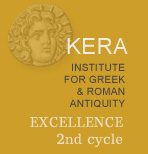Main Site . Other insciptions from the main site of Boubon
26. Honorary inscription for Nearchos IV
![]()
5 10 15 20 25 |
Βουβωνέων ἡ βουλὴ καί ὁ δῆ͜μος ἐτείμ͜ησεν ταῖς ἀξίαις τειμαῖς Νέ– αρχον τετράκι τοῦ Μολέσεος, Βουβων͜έα, συν͜γεν͜ῆ Λυκιαρχῶν, γονέων καὶ προγόνων ͜πρωτευ– σάν͜των τῆς πατρίδος, ἀρξάν͜των τὰς πρωτευούσας ἀρχὰς ἀνα– λόγως τοῦ γένους καί τῆς τά– ξεως, σεμ͜νὸν καὶ μεγαλό– φρονα καὶ πάσῃ τέλιον ἀ– ρετῇ καὶ παιδείᾳ πρέποντα τῶν γονέων αὐτοῦ καὶ προγό– νων ἱερασαμένων τῶν Θεῶν Σεβαστῶν καὶ ἑσ– τιασάν͜των πάν͜τας πλου– σίως καὶ ἐπιδόσεις π͜εποιημ͜έ– νων, σειτομετρησάντων ἐκτενῶς, γραμ͜ματευσάν͜των ἐπω– φελῶς καί ἐπιδόσεις ποιησαμέ– νων, γυμ͜νασιαρχησάν͜των καὶ τὴ͜ν θέσιν τοῦ ἐλαίου ποιησαμ͜έ– νων ἐν τῷ γυμ͜νασίῳ ἐκτενῶς καὶ πλουσίως, καί τάς ἄλλας πάσας ἀρχὰς ἐκτενῶς καὶ μ͜εγαλοφρόνως τετελεκότων. |
The council and the people of Boubon honored with the deserved honors Nearchos IV, great-great-grandson of Molesis, citizen of Boubon, kinsman of Lyciarchs, (descendant) of parents and ancestors who were front-ranking (citizens) in the city, who held the highest magistracies in accordance with their descent and their status, a noble and generous (youth), perfect in all virtue and education, worthy of his parents and ancestors who have been priests of the deified emperors and have given lavish banquets for all (citizens), have made distributions and dealt out corn (or: overseen the corn-dole) splendidly, who have been efficient public secretaries and made distributions, who have been gymnasiarchs and have provided the oil assiduously and lavishly, who have exercised all other offices with zeal and generosity.
Statue base with molded top and bottom, found by Hall in 1984 in Boubon (no further specification). In 2004 the stone was among those scattered on the west side of what seems to have been a substantial building on the southwest slope of the mountain of Boubon, near nos. 23, 25 and 32.
Height: 124 cm; length: (lower molding) 66.5 cm, (shaft): 48 cm; letters: 2-3 cm. The depth was not measurable because the stone was buried.
Milner (1994) (pl. 5.1); SEG 44 (1994), no. 1162; Milner 1998, p. 1, no. 1; SEG 48 (1998), 1567; SEG 49 (1999), 2514.
Ll. 2-4 : The honorand is most probably the prematurely deceased youth of no. 27 (Milner 1994, p. 94). No. 23 in honor of Artemion must have carried a statue of Nearchos' mother, since that woman was the wife of Nearchos III, son of Molesis. At this location in Boubon there may have been one or more family monuments of prominent citizens, maybe in the form of exedrae adorned with statues. On Μόλεσις see no. 72.
L. 10 : τέλιον instead of τέλειον on account of iotacism; cf. l. 2 ἐτείμησεν, τειμαῖς; l. 17. σειτομετρησάντων. The latter two spellings are common in inscriptions of imperial date, the spelling τειμ- being in fact more common than τιμ-.
Ll. 13-25 : The list of magistracies of Nearchos' ancestors, as presented here, supports the general impression that possession of high public posts in the cities of the Roman empire was normally connected with an expectation to perform certain liturgies (see Quaß 1993, pp. 303-328). Imperial priests are known to have given banquets and to have made distributions of money, something suggested by the formulation ἱερασαμένων τῶν Θεῶν Σεβαστῶν καὶ ἑστιασάντων πάντας πλουσίως καὶ ἐπιδόσεις πεποιημένων in ll. 13-17. Gymnasiarchs were likely to contribute to the purchase of oil used during athletic training or to provide that oil entirely at their own expense (Νίγδελης and Σουρής 2005, pp. 108-109), as Nearchos' ancestors did: γυμνασιαρχησάντων καὶ τὴν θέσιν τοῦ ἐλαίου ποιησαμένων ἐν τῷ γυμνασίῳ ἐκτενῶς καὶ πλουσίως (ll. 20-23). The secretaries of civic bodies (usually of the council: γραμματεύς τῆς βουλῆς, or the people: γραμματεύς τοῦ δήμου) fulfilled a multitude of duties, probably differing from city to city (Schulte 1994, pp. 9-138). We know little about largesses connected to such posts. The formulation of this inscription connects to the office of grammateus in Boubon, or at least to Nearchos' ancestors' exercise of it, ἐπιδόσεις, which can mean both voluntary contributions to the state and distributions of money among the citizens. Finally, there is a reference to a σιτομέτριον in ll. 17-18. If taken literally, σιτομετρῶ would refer to distributions of corn undertaken by Nearchos' family, but it may also point to a magistracy overseeing the corn dole. In either case, σιτομετρησάντων, in like manner to the other items of this list, probably implies contributions from private means. Holders of magistracies connected with the food supply are known to have made such contributions. In times of dearth, market inspectors (agoranomoi) might intervene in the market at their own expense in order to keep prices at an affordable level. In Aphrodisias for example (SEG 32 [1982], no. 1097): κ̣αὶ ἀγορανομήσαντα ἐν τῇ χαλεπωτάτῃ σιτοδείᾳ καὶ σῖτον εὔωνον̣ παράσχοντα τοῖς ἰδίοις ἀναλώμασιν. On the responsibilities of the market inspectors see most recently Jakab 1997, pp. 70-85 and Brélaz 2005, 72f. For Egypt see Alston 1997, pp. 147-172 (esp. pp. 157-158).

